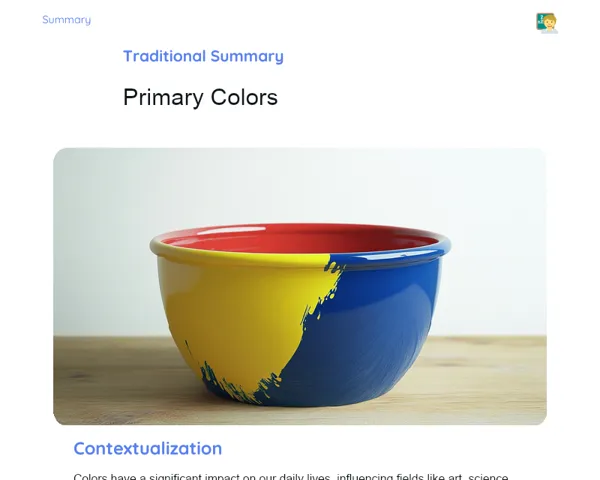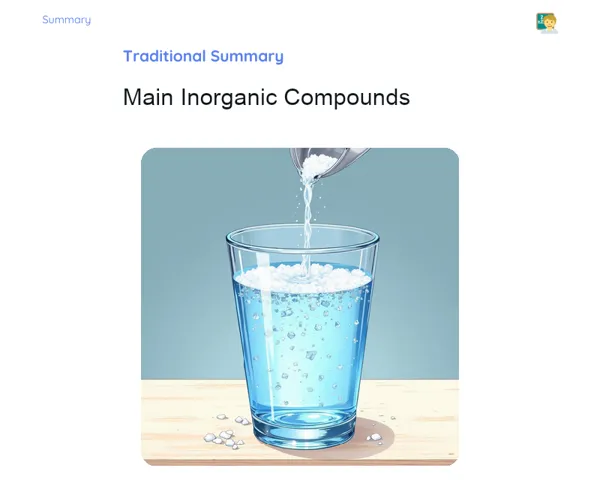Summary Tradisional | Layers of the Earth
Contextualization
Our planet, Earth, comprises several layers that are crucial for understanding its structure and dynamics. These layers — the crust, the mantle, and the core — each have unique characteristics that influence natural events like earthquakes, volcanic eruptions, and the formation of mountain ranges. By studying these layers, we can gain insights into the planet's internal mechanisms and the origins of various surface phenomena.
The crust is the outermost layer that we inhabit, made up of solid rocks and minerals. Beneath the crust lies the mantle, a thick layer that stretches to about 2,900 km deep, primarily consisting of silicate rocks. Finally, there’s the core, which is divided into the outer core and inner core. This innermost layer is mainly composed of iron and nickel and is responsible for generating Earth's magnetic field. Understanding these layers plays a key role in our grasp of geology and the processes that shape the Earth's surface.
To Remember!
Earth's Crust
The Earth's crust is the outermost layer where all living organisms thrive. It consists mainly of solid rocks and various minerals, including granite in the continental crust and basalt in the oceanic crust. The thickness of the crust varies significantly across the globe, measuring anywhere from as thin as 5 km in oceanic regions to as much as 70 km in continental areas. This variation directly relates to the type and density of the rocks forming each crust type.
The crust is classified into two primary segments: continental crust and oceanic crust. The continental crust is mostly composed of granite and a mix of igneous, sedimentary, and metamorphic rocks, making it thicker and less dense. On the flip side, the oceanic crust primarily consists of basalt, a high-density igneous rock, and is considerably thinner. These differences mirror the distinct geological processes present in each crust section.
The Earth's crust is fractured into massive slabs known as tectonic plates. These plates float on the semi-fluid layer of the upper mantle, called the asthenosphere, and their movement results in various geological wonders, such as earthquakes, volcanic activity, and mountain building. The dynamics between tectonic plates, which include collisions, separations, and shifts, continually shape the Earth's landscape.
-
The Earth's crust is the outermost layer where we live.
-
It is divided into continental crust and oceanic crust.
-
The crust is broken into tectonic plates that float on the asthenosphere.
Mantle
Located directly beneath the Earth's crust, the mantle extends to about 2,900 km deep. It's primarily made up of silicate rocks rich in magnesium and iron. The mantle is further partitioned into two key segments: the upper mantle and the lower mantle. The upper mantle, together with the crust, forms the lithosphere, which is rigid. Beneath this lies the asthenosphere, a semi-fluid layer that facilitates tectonic plate movement.
The asthenosphere is vital for conducting convection currents in the mantle, which stem from temperature and density variations. These currents play a critical role in the movement of tectonic plates that comprise the lithosphere, contributing to geological occurrences like mountain formation, earthquakes, and volcanic eruptions.
The mantle exhibits a rise in temperature and pressure with depth. In the upper mantle, temperatures range from 500°C to 900°C, while in the lower mantle, they can soar up to 4,000°C. Pressure also escalates significantly with depth, affecting the shape and behavior of the rocks. Even though the mantle rocks remain solid, they can flow slowly over time due to high pressure and temperatures.
-
The mantle extends to about 2,900 km deep.
-
It is split into the upper mantle and lower mantle.
-
The asthenosphere enables tectonic plate movement thanks to convection currents.
Core
As the innermost layer of the Earth, the core is divided into the outer core and the inner core. The outer core spans from roughly 2,900 km to 5,150 km deep and is predominantly comprised of liquid iron and nickel. Its fluid state fosters the creation of convection currents, which are integral for generating the Earth's magnetic field. This magnetic field is essential for shielding the planet from harmful solar radiation.
The inner core, on the other hand, is solid and stretches from the base of the outer core to the center of the Earth, around 6,371 km deep. Despite experiencing extreme temperatures reaching up to 6,000°C, the inner core remains solid due to intense pressure that prevents the iron from melting. The inner core predominantly consists of iron and nickel but remains solid because of these high-pressure conditions.
The core significantly influences the dynamics of our planet, not only by creating the magnetic field but also by impacting the convection currents within the mantle. The thermal energy generated in the core is transmitted to the mantle, fostering convection currents that help in the movement of tectonic plates. Thus, the core is indirectly associated with various geological processes occurring on the Earth's surface.
-
The core consists of a liquid outer core and a solid inner core.
-
The outer core is responsible for generating Earth's magnetic field.
-
The inner core remains solid despite extreme temperatures due to high pressure.
Tectonic Plate Movement
Understanding the movement of tectonic plates is crucial for grasping the dynamics of the Earth's crust. Tectonic plates are vast blocks of the lithosphere that float on the semi-fluid asthenosphere. Their movement is primarily influenced by convection currents in the mantle, driven by temperature and density differences within the Earth.
We can categorize plate boundaries into three main types: convergent, divergent, and transform boundaries. At convergent boundaries, plates collide, which can lead to mountain formation or subduction, wherein one plate gets pushed underneath another and melts in the mantle. At divergent boundaries, plates drift apart from each other, allowing magma from the mantle to rise and create new crust, which happens at mid-ocean ridges. Transform boundaries occur when plates slide past one another horizontally, resulting in earthquakes along faults.
The movement of tectonic plates is behind many geological events we observe on the planet's surface, including the formation of mountains, earthquakes, and volcanic activity. This constant motion also impacts the distribution of continents and oceans over geological time, molding the Earth's configuration. Understanding how tectonic plates operate and interact is vital for predicting and managing the effects of natural disasters.
-
Tectonic plates float on the asthenosphere and are driven by convection currents in the mantle.
-
There are three primary types of plate boundaries: convergent, divergent, and transform.
-
The movement of tectonic plates gives rise to phenomena like earthquakes, volcanic eruptions, and mountain formation.
Key Terms
-
Earth's Crust: The outermost layer of the Earth, made up of solid rocks and minerals.
-
Mantle: The layer beneath the crust, consisting of silicate rocks, and is divided into the upper and lower mantle.
-
Core: The innermost layer of the Earth, chiefly made of iron and nickel, further divided into the liquid outer core and solid inner core.
-
Tectonic Plates: Large blocks of the lithosphere that float on the asthenosphere, moved by convection currents in the mantle.
-
Asthenosphere: The semi-fluid layer of the upper mantle that enables the movement of tectonic plates.
-
Convection: Movements in the mantle driven by temperature and density differences, propelling tectonic plate motion.
-
Magnetic Field: The field produced by the Earth's outer core, shielding the planet from solar radiation.
-
Subduction: The event where one tectonic plate gets pushed beneath another and melts in the mantle.
-
Mid-Ocean Ridge: A zone where tectonic plates diverge, allowing magma to rise and create new crust.
Important Conclusions
In this summary, we examined the primary layers of the Earth: the crust, mantle, and core. The crust is our living layer, made of solid rocks and minerals, and consists of both continental and oceanic sections. The mantle, lying beneath the crust, is a thick layer rich in silicate rocks, divided into upper and lower segments. The asthenosphere, a semi-fluid part of the upper mantle, aids in tectonic plate movement. Finally, the core, the innermost layer, consists of a liquid outer core and a solid inner core, primarily made of iron and nickel, and plays a critical role in forming Earth's magnetic field.
Understanding the Earth's internal structure is pivotal for comprehending numerous natural occurrences, such as earthquakes, volcanic eruptions, and the formation of mountains. The continuous movement of tectonic plates, driven by mantle convection currents, is a key process that shapes our planet's surface and affects all life forms. Additionally, the magnetic field generated by the outer core serves as a protective barrier against solar radiation, demonstrating the interconnectedness of the Earth’s layers.
The insights we gain about these layers are not just essential for geology; they also hold practical significance for forecasting and managing natural disasters. We encourage students to delve deeper into this captivating subject, as it enhances our understanding of our planet and aids in devising solutions to geological challenges.
Study Tips
-
Look at diagrams and images of the Earth's layers for a clearer understanding of the differences between the crust, mantle, and core.
-
Explore natural phenomena like earthquakes and volcanic eruptions to appreciate their relation to tectonic plate movements.
-
Investigate Earth's magnetic field and its crucial role in protecting our planet from solar radiation.



